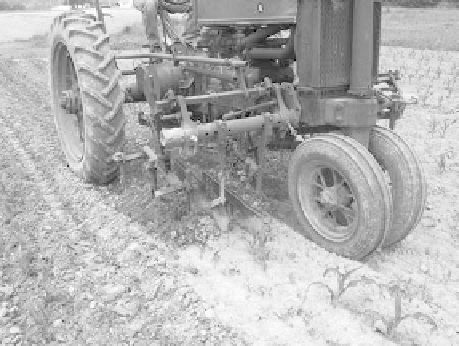Agriculture Reference
In-Depth Information
the farmer must again go through the field two to three times to destroy weeds. If weeds
are not controlled, as much as 75 percent of the grain yield may be lost. Insect attacks
are not always spectacular. More frequently the European corn borer will attack 10 to
15 percent of the field, leaving stalks without ears or with ears partially eaten by worms.
Rootworms will attack the crop below the surface causing slow, but measurable, yield
losses. Controlling weeds before World War II was done by tractor-mounted cultivators
driving slowly through maize fields to remove weeds (see Figure 12.11). Hand weeding
was needed since the tractor could not remove weeds in the row between the maize
plants. This was expensive because of the cost of gasoline or diesel fuel used each
time the tractor traveled over a field. It was also time consuming since each tractor
needed a driver and each hoe needed a person handling it.
The practice of no-till was developed in the United States in the 1960s when her-
bicide use for maize became widespread. Since weeds could be controlled with one
application of a chemical, time and costs were drastically reduced. This also meant
that one farmer could plant several hundred hectares of maize without help, further
reducing production costs. Research done in the 1960s showed that when weeds
could be controlled by herbicides, tillage (plowing and disking) could be reduced or
even eliminated with no loss of yield. This meant that the farmer could plant a field
without previously plowing and disking. Weeds could be removed in one single oper-
ation without disturbing the soil and erosion was greatly reduced. With a slightly modi-
fied planter, the farmer was able to raise a crop of maize with only three operations:
planting, spraying, and harvesting. Costs were further reduced. The only problem
was that increasingly potent and complex combinations of herbicides were needed to
kill the thousands of weed species in maize fields. One of the most common herbicides
was atrazine. At low concentrations it had little effect on maize but controlled many
weeds. Disadvantages were that it only controlled certain broadleaf and grassy
weeds. Atrazine also had limited residual activity at typical rates, controlling weeds
Figure
12.11.
Mechanical weed control in maize.









